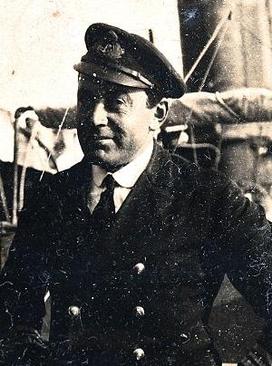Geoffrey Saxton White facts for kids
Quick facts for kids
Geoffrey Saxton White
VC
|
|
|---|---|
 |
|
| Born | 2 July 1886 Bromley, Kent |
| Died | 28 January 1918 (aged 31) Dardanelles, Ottoman Turkey |
| Buried |
Portsmouth Naval Memorial
|
| Allegiance | |
| Service/ |
|
| Years of service | 1902-1918 |
| Rank | Lieutenant Commander |
| Commands held | HMS E14 |
| Awards | |
Geoffrey Saxton White VC (2 July 1886 – 28 January 1918) was a very brave officer in the Royal Navy from England. He received the Victoria Cross, which is the highest award for courage in the face of the enemy. This special medal is given to members of the British and Commonwealth armed forces.
Contents
Geoffrey Saxton White went to school at Bradfield College. In September 1902, he joined the navy as a naval cadet. He served on a large warship called HMS Aboukir. This ship was part of the Mediterranean Fleet, which operated in the Mediterranean Sea.
He was 31 years old and held the rank of Lieutenant-Commander during World War I. It was during this war that he earned his Victoria Cross.
Heroic Action: Earning the Victoria Cross
On 28 January 1918, Lieutenant-Commander White was in charge of the British submarine E.14. Their mission was to find a German warship called Goeben in the Dardanelles area of Turkey. The Goeben was thought to be stuck on the ground.
The Dangerous Mission
Submarine E.14 did not find the Goeben, so they started to head back. But then, an amazing and dangerous series of events happened. For his actions that day, Lieutenant-Commander White was given the Victoria Cross after he died. The award was announced on 24 May 1919.
The official report praised his incredible bravery and dedication to duty. Here is what happened:
E.14 had left a place called Mudros on January 27. Their goal was to get through a narrow waterway called the Narrows. They wanted to attack the Goeben, which had been damaged and was stuck near Nagara Point.
Facing Enemy Fire
Since the Goeben wasn't found, E.14 turned around. Around 8:45 in the morning on January 28, E.14 fired a torpedo at an enemy ship. Just 11 seconds after the torpedo left the submarine, a huge explosion shook E.14. All the lights went out, and the front hatch of the submarine was damaged and began to leak.
The submarine quickly rose to just 15 feet below the surface. Immediately, heavy gunfire came from enemy forts on the shore. Luckily, the submarine's main body was not hit. E.14 then dived deeper and continued trying to leave the area.
A Commander's Sacrifice
Soon after, the submarine became very difficult to control. The air inside was also running out. Lieutenant-Commander White made a very risky decision: he decided to bring the submarine to the surface. He hoped this would give his crew a chance to survive.
As soon as E.14 surfaced, heavy gunfire started from both sides of the waterway. For half an hour, the submarine bravely tried to escape, with the crew steering it from below. E.14 was badly damaged by the constant shelling.
Seeing that the submarine was sinking, Lieutenant-Commander White turned it towards the shore. He wanted to give his crew the best chance to get to safety. He stayed on the deck of the submarine the entire time, guiding his crew. Sadly, he was killed by an enemy shell while still on deck.
Legacy and Remembrance
Geoffrey Saxton White's body was not found at the time of the battle. Because of this, he does not have a known grave. However, his bravery is remembered. His name is listed on the Portsmouth Naval Memorial. This memorial honors naval personnel who died in service and have no known grave.

